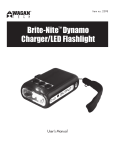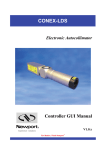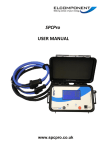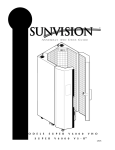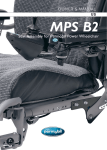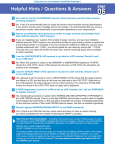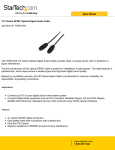Download the latest FJ-500 Manua
Transcript
FJ-500 CELL PHONE INTERFACE MIXER O P E R A T I N G M A N U A L CONEX Manual Version 102706 E L E C T R O - S Y S T E M S , I N C TUNER IN AUX MIC 1 Air Receive Send Mic 2/Line AUX Receive Level Cell/Land Line Switch Send Level Send Receive MINIDISK PA SYSTEM, ETC HEADPHONE JACKS CELL PHONE JACK LAND LINE JACK LED VU METER FlipJack FJ-500 CELL PHONE INTERFACE MIXER Cassette Player/MiniDisk Player/Wireless Mic, etc. FlipJack Specifications AUDIO INPUTS MIC 1 XLR Female jack. Transformer balanced and isolated. 600Ω MIC 2/LINE XLR Female jack. Transformer balanced and isolated 600Ω. Gain switchable from 0 dB (line position) to -50 dB (Mic position). AUX IN 3.5 mm miniature phone jack accepts balanced audio from a portable mini-disk player, remote console, etc. TUNER IN 3.5 mm miniature phone jack accepts balanced audio from a portable radio or TV tuner. Un-balanced input, level controlled by the tuner. Cell Phone AUDIO OUTPUTS Remote Mixer AUX OUT PHONES A 3.5 mm stereo phone jack feeds balanced audio to any external device such as a recorder. Level is nominally -10 dBm. Transformer balanced and isolated. Output source is selectable via an internal jumper. Tuner/Portable Radion input for ‘Off Air’ Monitoring. FlipJack Back Panel Two 1/4” stereo phone jacks feed FlipJack audio to a 32 Ω - 600Ω headphone. The headphone jacks have their own front panel level control. CONTROLS MONITOR This switch selects what the headsets will hear. The Monitor Switch postions are: AIR The audio feeding the TUNER IN jack RCV The audio RECEIVED by the Cell Phone SEND The audio that is being SENT to the cell phone. MIC2/LINE The audio on the MIC2/LINE channel AUX The audio on the AUX channel The 2.5 mm jack on some Motorola phones is indented into the case. This prevents the cable that connects the cell phone to the FlipJack from being plugged in all the way. The solution to this is to trim away some of the soft plastic on the 2.5 mm plug on the FlipJack cable. See the photos below. SEND LEVEL Adjusts audio level sent from Mic/Line Inputs to cell phone. RCV LEVEL Adjusts audio level sent from cell phone to the head phone monitor amplifier. SIZE 4.5” W X 4” D X 1.35” H POWER 3 ‘AA’ Alkaline batteries or external 6 - 19 VDC Manual Version 102706 5 Additional Comments: FlipJack FJ-500 User Manual Adaptors are available for some phones that don’t have a 2.5 mm hands free jack built in. This is the case for many Nokia, Sony-Ericcson and Motorola phones. Contact Conex for more information. We don’t recommend using Nextel phones because of the unusually high amount of digital interference that is transmitted by these phones. The FlipJack can be used with portable land-line phones that have a built-in 2.5 mm earphone jack. Many FlipJack customers are using wireless microphones as a way of getting crowd noise while broadcasting ball games from booths. When using the FlipJack on a land line, the transmitted audio level may be too low. If this is the case, try using another brand of telephone. The battery life is approximately 30 hours. The AUX input can be use with any line level input such as mini disk layers, wireless mics, cassette decks, remote mixers etc. This input is balanced in - mono. You will have to modify the connecting cable if you have a stereo source. Seewww.conex-electro.com for more information. The Headphones MUST have STEREO plugs Be sure to turn the power OFF when you are through with the unit to conserve battery life. NOTE: The power switch only controls the battery power supply ... it does not turn the FJ-500 off when external power is connected batteries. The audio should be adjusted so that the right most LED flashes just occasionally. Steady flashing could be an indication of over driving the cell phone which could cause distortion. If you want to listen to an off-air signal while using the FlipJack, connect a portable radio to the TUNER IN jack and put the MONITOR switch in the AIR position. The Conex FJ-500 FlipJack is a compact adaptor that allows easy remote broadcasts via your pocket cell phone. It interfaces to various broadcast audio sources and is designed to work with any cell phone with a 2.5 mm hands-free adaptor jack. Use the FlipJack with your own remote mixers, tape recorders, microphones, headphones etc. for immediate and cost effective remotes. • • • • • • • • • • • • Two Mic Inputs (XLR jacks) (Mic 2 is switchable to a line input). Separate balanced input for AUX audio Two 1/4” Headphone jacks …each with it’s own level control Monitor switch which allows monitoring a variety of audio sources Send level adjustment (audio sent to the cell/landline phone) Receive level adjustment (audio received from the cell/landline phone) Front panel low-battery and audio level indicators Compact (4.5” x 4” x 1.35”) including knobs Operates on 3 ‘AA’ alkaline batteries or external power (6 – 19 VDC) Front panel power switch RJ-11 connector allows FJ-500 to be connected to a standard telephone IC’s are socketed for easy maintenance LED VU Meter Headphone Level MIC2/LINE Level AUX Level The RECEIVE level should be adjusted to provide an adequate level in your headphones while listening to someone talk at the other end of the connection. The SEND level should be adjusted to provide an adequate level at the STUDIO end. Turning the SEND level to high will over drive your cell phone and cause distorted, garbled audio. Some cell phones don’t provide side tone audio. If this is the case, you won’t be able to hear yourself in your headset when the monitor switch is in the RCV position. To accommodate these phones, we have added a “side tone” adjustment on the side of the FJ-500. Turn this control up until you have adequate level in your headphones. 4 MIC 1 Level LOW BATTERY Indicator Power Switch (For controlling the internal batteries only) Headphone Jacks Headphone Monitor Switch (Normally left in “Receive”) 1 The Conex FlipJack provides a simple means for interfacing audio equipment to a pocket-style cell phone at a remote broadcast site. It is specifically designed to work with any cell phone that has a 2.5 mm hands free adaptor jack. The FlipJack provides two transformer-isolated and balanced XLR inputs, one with switchable gain for line or microphone use, and a transformer isolated balanced line input. Each of the XLR inputs allows for connection to standard broadcast dynamic microphones and MIC 2 also allows for an external line level input such as a mixer. The two stereo headset jacks allow monitoring of a variety of audio sources including: AIR ... the off-air signal provided by an external tuner or portable radio when it is fed to the TUNER input. RCV ... The receive audio is the audio that is received from the cell phone. This is useful for listening for cues from the station. SEND ... This is the audio that is sent back to the station from the cell phone. MIC2/LINE ... Listen to audio on the MIC2/LINE input. AUX ... Listen to audio feeding the AUX input. 8. Put the monitor switch in the RCV position. Call your studio on the cell phone and have an associate listen while you speak into the microphone. Adjust the SEND LEVEL control with a small screwdriver while your associate listens for adequate loudness and minimum distortion. This is a one time adjustment unless the FlipJack is used with a different phone. NOTE: You should hear yourself in your headset when the switch is in the RCV position and you are connected to someone via your cell phone or land line phone. If you can’t, you might have to adjust the Side Tone Level control on the side of the unit. See the drawing below. Send Level Receive Level Side Tone Level External Power INSTALLATION The FlipJack is designed to interface with pocket-style cell phones that have a 2.5 mm hands free adaptor jack. Installing the FJ-500 FlipJack is simple. 1. Turn OFF the cell phone. 2. Plug one end of the provided 4 foot cable into the 2.5 mm hands free adaptor on your cell phone. 9. Connecting to land line phones: We recommend using a standard desk type telephone where the curly cord can be disconnected from the handset (see illustration below). The free end of the curly cord is then plugged into the connector on the back of the FJ-500. The “Land Line”/ “Cell” switch is put in the “Land Line” position. Older style rotary dial phones and phones that have a keypad in the handset will not work with the . 3. Plug the loose end (3.5 mm end) of this cable into the connector labeled CELL on the back of the FlipJack. 4. Plug in the microphone(s), headset(s) and any external devices to the appropriate connectors on the FlipJack. If a microphone is plugged into the MIC 2/LINE position, make sure the MIC/LINE switch on the back panel is set to MIC. 5. Turn the FlipJack power ON by pressing the ON button on the front panel. The front panel LEDs will flash on and then turn off. If the internal ‘AA’ batteries are low, the LOW BAT LED on the front panel will turn on. 6. Turn the cell phone on and set the front panel monitor switch to “SEND” 7. While speaking into the microphone, adjust its level control until the front panel LEDs flash. The last LED (on the far right) should flash occasionally. If it flashes continuously, it might indicate excessive audio drive for your cell phone and cause distortion. 2 3





